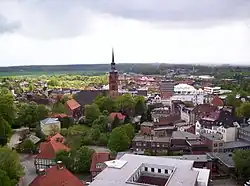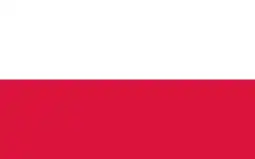Itzehoe | |
|---|---|
 Center of the town | |
 Coat of arms | |
Location of Itzehoe within Steinburg district  | |
 Itzehoe  Itzehoe | |
| Coordinates: 53°55′30″N 9°30′59″E / 53.92500°N 9.51639°E | |
| Country | Germany |
| State | Schleswig-Holstein |
| District | Steinburg |
| Government | |
| • Mayor | Ralf Hoppe (Ind.) |
| Area | |
| • Total | 28.03 km2 (10.82 sq mi) |
| Elevation | 22 m (72 ft) |
| Population (2022-12-31)[1] | |
| • Total | 32,258 |
| • Density | 1,200/km2 (3,000/sq mi) |
| Time zone | UTC+01:00 (CET) |
| • Summer (DST) | UTC+02:00 (CEST) |
| Postal codes | 25501−25524 |
| Dialling codes | 04821 |
| Vehicle registration | IZ |
| Website | www.itzehoe.de |
Itzehoe (German: [ɪtsəˈhoː] ⓘ; Low German: Itzhoe) is a town in Schleswig-Holstein in northern Germany.
As the capital of the district Steinburg, Itzehoe is located on the Stör, a navigable tributary of the Elbe, 51 km (31.7 mi) northwest of Hamburg and 24 km (14.9 mi) north of Glückstadt. The population is about 32,530.
History

Itzehoe is the oldest town in Holstein. Its nucleus was a castle, built in 809 by Egbert, one of Charlemagne's counts, against the Danes. The community that sprang up around it was variously called Esseveldoburg, Eselsfleth and Ezeho. In 1201 the town was destroyed but it was restored in 1224. The new town was granted the Lübeck rights by Adolphus IV in 1238 and the old town in 1303. During the Thirty Years' War Itzehoe was twice destroyed by the Swedes, in 1644 and 1657, but was rebuilt on each occasion. It was under Danish rule until the Second Schleswig War of 1864, when it was occupied by Austria. In 1867, it passed to Prussia,[2] and in 1871 it became part of the newly established German Empire.
Itzehoe was listed as a garrison depot (Wehrkreis X (Hamburg)) of the former 225th Infantry Division, which was implicated in the 1940 Vinkt Massacre in Belgium.
Following the joint German-Soviet invasion of Poland, which started World War II in September 1939, it was the location of the Oflag X-A prisoner-of-war camp for Polish officers, which was eventually relocated to Sandbostel in 1941.[3] During the war, Itzehoe was not initially a primary target for the Allied strategic bombing campaign, but was hit by an Allied bombing raid very late in the war, when Allied carpet bombing on 2 May 1945 (just two days before the German surrender at Lüneburg Heath) caused 22 fatalities in the city.[4]: 436
Climate
Itzehoe has an oceanic climate (Cfb in the Köppen climate classification).
| Climate data for Itzehoe (1991–2020 normals, extremes 1988–present) | |||||||||||||
|---|---|---|---|---|---|---|---|---|---|---|---|---|---|
| Month | Jan | Feb | Mar | Apr | May | Jun | Jul | Aug | Sep | Oct | Nov | Dec | Year |
| Record high °C (°F) | 14.7 (58.5) |
18.1 (64.6) |
22.5 (72.5) |
26.9 (80.4) |
32.2 (90.0) |
33.6 (92.5) |
36.9 (98.4) |
34.9 (94.8) |
30.9 (87.6) |
26.4 (79.5) |
20.2 (68.4) |
14.6 (58.3) |
36.9 (98.4) |
| Mean daily maximum °C (°F) | 4.1 (39.4) |
4.9 (40.8) |
8.3 (46.9) |
14.1 (57.4) |
17.7 (63.9) |
20.8 (69.4) |
23.0 (73.4) |
22.6 (72.7) |
19.1 (66.4) |
13.8 (56.8) |
8.6 (47.5) |
5.6 (42.1) |
13.5 (56.3) |
| Daily mean °C (°F) | 2.0 (35.6) |
2.3 (36.1) |
4.3 (39.7) |
8.7 (47.7) |
12.5 (54.5) |
15.5 (59.9) |
17.7 (63.9) |
17.5 (63.5) |
14.2 (57.6) |
10.3 (50.5) |
6.1 (43.0) |
3.4 (38.1) |
9.5 (49.1) |
| Mean daily minimum °C (°F) | −0.7 (30.7) |
−0.8 (30.6) |
0.2 (32.4) |
3.2 (37.8) |
6.6 (43.9) |
10.0 (50.0) |
12.2 (54.0) |
12.1 (53.8) |
9.4 (48.9) |
6.2 (43.2) |
3.1 (37.6) |
0.9 (33.6) |
5.2 (41.4) |
| Record low °C (°F) | −14.0 (6.8) |
−18.2 (−0.8) |
−21.3 (−6.3) |
−5.9 (21.4) |
−3.1 (26.4) |
0.5 (32.9) |
5.4 (41.7) |
3.1 (37.6) |
0.3 (32.5) |
−7.9 (17.8) |
−9.7 (14.5) |
−15.7 (3.7) |
−21.3 (−6.3) |
| Average precipitation mm (inches) | 85.9 (3.38) |
63.3 (2.49) |
53.7 (2.11) |
33.4 (1.31) |
61.3 (2.41) |
76.5 (3.01) |
99.9 (3.93) |
94.0 (3.70) |
70.3 (2.77) |
74.8 (2.94) |
75.4 (2.97) |
87.5 (3.44) |
883.9 (34.80) |
| Average precipitation days (≥ 1.0 mm) | 19.5 | 16.4 | 15.3 | 13.1 | 14.2 | 15.3 | 16.5 | 17.8 | 15.3 | 17.1 | 18.8 | 20.7 | 201.0 |
| Average relative humidity (%) | 89.2 | 86.2 | 81.3 | 74.7 | 73.6 | 75.3 | 76.2 | 78.6 | 82.7 | 86.3 | 90.0 | 91.0 | 82.1 |
| Mean monthly sunshine hours | 40.3 | 66.6 | 123.1 | 193.9 | 227.1 | 218.4 | 225.1 | 191.4 | 154.8 | 110.7 | 52.3 | 33.3 | 1,630.7 |
| Source 1: World Meteorological Organization[5] | |||||||||||||
| Source 2: DWD (extremes)[6] | |||||||||||||
Sights
The Church of St. Laurentii and the building in which the Holstein estates formerly met are noteworthy. The town has a convent founded in 1256, many schools, a hospital and other benevolent institutions.[2]
Itzehoe is also the location of the Wenzel Hablik Museum.
Transport
Itzehoe is situated at the Marsh Railway and offers connections to Hamburg and the island of Sylt.
During the period up to and including the Wacken Open Air festival many festival goers depart for the festival from Itzehoe using the 'Metal Shuttle Bus’, which leaves from near Itzehoe station. During this time the town can become very overcrowded and inundated with traffic.
Twin towns – sister cities
 Cirencester, England, United Kingdom
Cirencester, England, United Kingdom La Couronne, France
La Couronne, France Pasłęk, Poland
Pasłęk, Poland
Notable people
.jpg.webp)

- Adolf IV of Holstein (before 1205–1261), a Count of Schauenburg (1225–1238)
- Johannes Loccenius (1598–1677), a German jurist and historian
- Joachim Irgens von Westervick (1611-1675), Dano-Norwegian official and estate owner, important financial magnate and entrepreneur
- Bendix Grodtschilling (ca 1620 – 1690), a Danish painter and carpenter.
- Werner Fabricius (1633-1679), organist and composer
- Bendix Grodtschilling the Younger (1655–1707), a Danish painter.
- Ludvig Nicolaus von Scheele (1796–1874), a Danish statesman, Danish Foreign Minister, 1855 to 1857.
- Carl Julian (von) Graba (1799–1874), German lawyer and ornithologist who visited and studied the Faroe Islands
- Peter Christoph Hagemann (1810–1853), neoclassical Danish architect
- Hans Peder Pedersen-Dan (1859–1939), a Danish sculptor.
- Elisabeth Lindemann (1879–1960), weaver, textile designer and photographer; lived locally from 1917.
- Bruno Adler, (DE Wiki) (1896–1954), Bishop of the German Christians
- Erika Thimey (1910–2006), dancer and dance educator, mainly based in Washington, D.C.
- Sabine Sinjen (1942–1995), film actress
- Jerzy Janeczek (1944–2021), Polish theater and film actor.
- Antje Blumenthal (born 1947), politician
- Sylvia Convey (born 1948), Latvian-Australian artist
- Olaf Berner (born 1949), teacher and handball player
- Heiger Ostertag (born 1953), historian and novelist.
- Thomas Gerull (born 1962), fencer, team silver medalist at the 1988 Summer Olympics
- Sven Butenschön (born 1976), ice hockey player
- Lisa Tomaschewsky (born 1988), film and TV actress.
References
- ↑ "Bevölkerung der Gemeinden in Schleswig-Holstein 4. Quartal 2022" (XLS) (in German). Statistisches Amt für Hamburg und Schleswig-Holstein.
- 1 2 One or more of the preceding sentences incorporates text from a publication now in the public domain: Chisholm, Hugh, ed. (1911). "Itzehoe". Encyclopædia Britannica. Vol. 15 (11th ed.). Cambridge University Press. p. 87.
- ↑ Megargee, Geoffrey P.; Overmans, Rüdiger; Vogt, Wolfgang (2022). The United States Holocaust Memorial Museum Encyclopedia of Camps and Ghettos 1933–1945. Volume IV. Indiana University Press, United States Holocaust Memorial Museum. p. 261. ISBN 978-0-253-06089-1.
- ↑ Irmisch, Rudolf (1960). "Die Zeit des Nationalsozialismus (1933–1945)". Geschichte der Stadt Itzehoe. Itzehoe: Gruner & Sohn. pp. 424–439.
- ↑ "World Meteorological Organization Climate Normals for 1991–2020". World Meteorological Organization Climatological Standard Normals (1991–2020). National Oceanic and Atmospheric Administration. Archived from the original on 12 October 2023. Retrieved 12 October 2023.
- ↑ "Extremwertanalyse der DWD-Stationen, Tagesmaxima, Dekadenrekorde, usw" (in German). DWD. Retrieved 18 November 2023.
- ↑ "Städtepartnerschaften". itzehoe.de (in German). Itzehoe. Retrieved 2021-02-15.
External links
- Itzehoe Notgeld (emergency banknotes) depicting the inflation of staple prices in Germany between 1913 and 1921